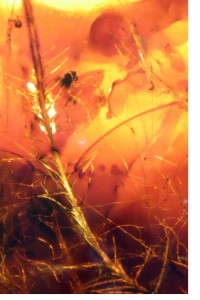THURSDAY, 22 SEPTEMBER 2011
 The specimens were discovered in samples from the Late Cretaceous that had been collected from the Grassy Lake region of Alberta. Previous feather specimens have often been found as carbonized compression fossils which lack structural details, but the amber preserves microscopic details of the feathers and even their pigment or colour. [1] [2]
The specimens were discovered in samples from the Late Cretaceous that had been collected from the Grassy Lake region of Alberta. Previous feather specimens have often been found as carbonized compression fossils which lack structural details, but the amber preserves microscopic details of the feathers and even their pigment or colour. [1] [2]Feathers are postulated to have evolved in a series of five stages, beginning as a simple filament and then gaining complexity by the addition of barbs and smaller barbules.
The samples in this study were found to encompass a range of evolutionary stages: some are early protofeathers, which are likely to have had important non-ornamental functions, such as thermoregulation and protection. Other feathers are highly complex and appear to be adapted to different functions; some may have enabled flight, and some are most likely associated with diving behaviour as they resemble those of the modern Grebe.
The findings suggest that a wide range of evolutionary stages were present in the Late Cretaceous, and that feathers already served a range of functions at that time, making dinosaurs less drab and scaly than was previously thought.
Written by Catherine Moir
